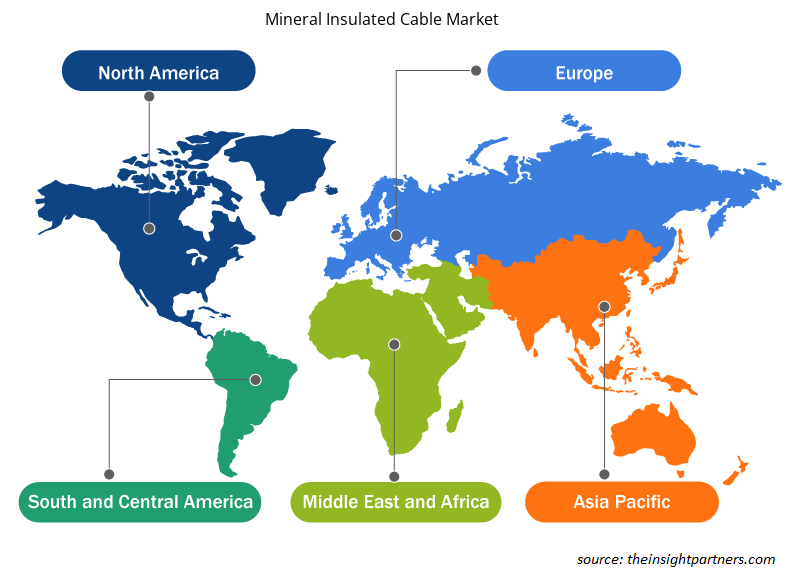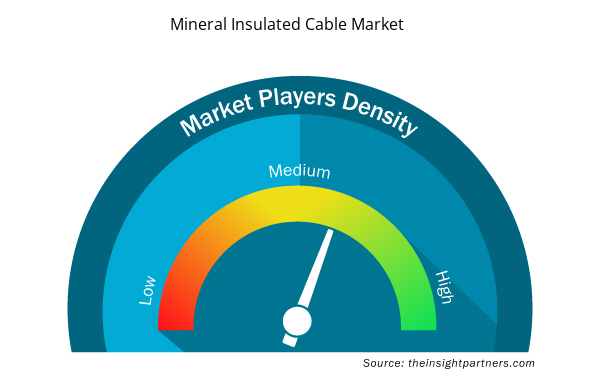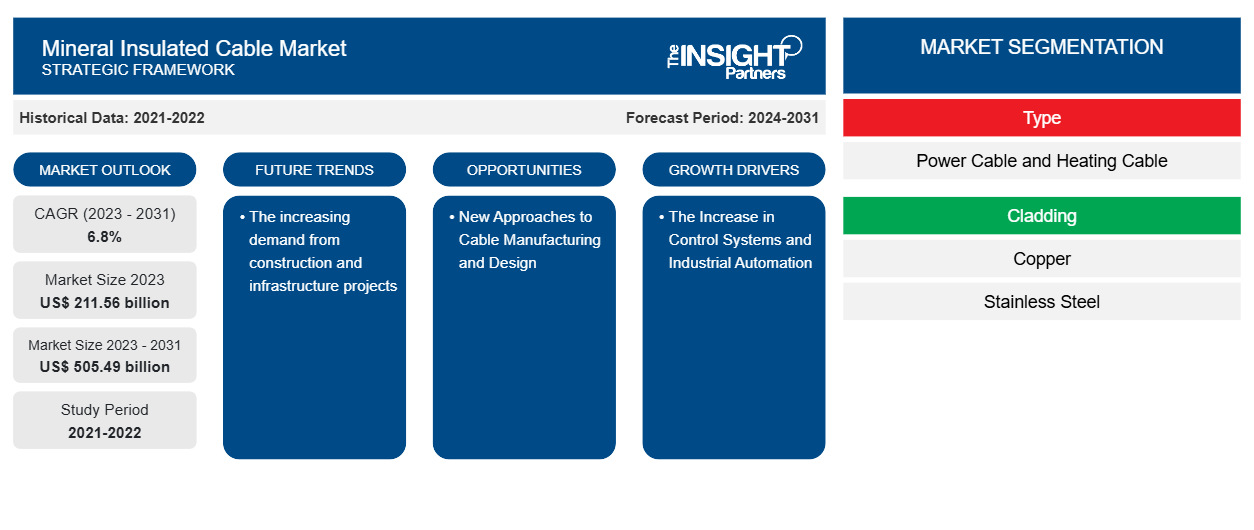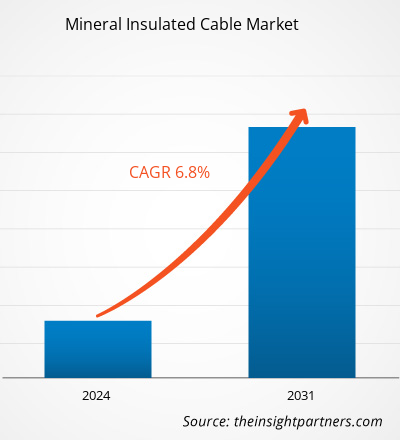Der Markt für mineralisolierte Kabel soll von 211,56 Milliarden US-Dollar im Jahr 2023 auf 505,49 Milliarden US-Dollar im Jahr 2031 anwachsen. Der Markt soll zwischen 2023 und 2031 eine durchschnittliche jährliche Wachstumsrate (CAGR) von 6,8 % verzeichnen. Die steigende Nachfrage aus Bau- und Infrastrukturprojekten dürfte ein wichtiger Trend auf dem Markt für mineralisolierte Kabel bleiben.
Mineralisolierte Kabel Marktanalyse
Der steigende Bedarf an Strom und Energie treibt die mineralisolierte Kabelindustrie weltweit an. Weitere Wachstumstreiber sind die zunehmende Fertigung und Schwerindustrie sowie steigende Haushaltseinkommen. Neben der Implementierung modernster Technologie und steigenden Investitionen werden die Hersteller in den kommenden Jahren viele Perspektiven in der mineralisolierten Heizkabelindustrie haben. Da die Magnesiumoxid-Isolierung in mineralisolierten Kabeln (MICC) alle anderen Materialien in Bezug auf Strahlenschutz übertrifft, sind MICC-Kabelbaugruppen eine hervorragende Option für Anwendungen in Kernkraftwerken.
Marktübersicht für mineralisolierte Kabel
Um mineralisolierte (MI) Kabel herzustellen, werden Kupferstäbe in ein rundes Kupferrohr mit hoher Leitfähigkeit eingesetzt und die Zwischenräume mit anorganischem trockenem Magnesiumpulver gefüllt, das als feuerfeste Isolierung und Dichtung dient. Danach wird die gesamte Baugruppe zwischen Rollen gepresst, um ihren Durchmesser zu verlängern und zu verringern, wodurch das Kabel feuerbeständiger und danach voll funktionsfähig wird. Für jeden Stromkreis bieten mineralisolierte Kabel eine praktikable oder langfristige Lösung. Sie beseitigen das mit Leitungen und Kabeln verbundene Risiko sowie die Kosten für zusätzliche Komponenten wie Zugkästen, Verbindungen, Erdungsdrähte, Leitungsdichtungen und andere Armaturen.
Passen Sie diesen Bericht Ihren Anforderungen an
Sie erhalten kostenlos individuelle Anpassungen an jedem Bericht, einschließlich Teilen dieses Berichts oder einer Analyse auf Länderebene, eines Excel-Datenpakets sowie tolle Angebote und Rabatte für Start-ups und Universitäten.
- Holen Sie sich die wichtigsten Markttrends aus diesem Bericht.Dieses KOSTENLOSE Beispiel umfasst eine Datenanalyse von Markttrends bis hin zu Schätzungen und Prognosen.
Treiber und Chancen auf dem Markt für mineralisolierte Kabel
Die Zunahme von Steuerungssystemen und industrieller Automatisierung
Damit industrielle Automatisierungs- und Steuerungssysteme reibungslos und sicher funktionieren, sind leistungsstarke Kabellösungen erforderlich. Diese Anwendungen eignen sich gut für mineralisolierte Kabel, die einen hervorragenden Schutz gegen mechanische Beanspruchung, erhöhte Temperaturen und elektromagnetische Störungen (EMI) bieten. Die Nachfrage nach mineralisolierten Kabeln für den Einsatz in Steuerungssystemen, Maschinen und Geräten wird voraussichtlich steigen, da Unternehmen ihre Prozesse automatisieren und digitalisieren.
Neue Ansätze für Kabelherstellung und -design
Entwicklungen im Kabeldesign und in der Produktionstechnologie treiben Innovationen auf dem Markt für mineralisolierte Kabel voran. Um den sich ändernden Verbraucheranforderungen gerecht zu werden, entwickeln Hersteller Kabel mit größerer Flexibilität, Biegeradius und Installationseffizienz. Darüber hinaus werden Leistung und Funktionalität mineralisolierter Kabel durch die Integration intelligenter Funktionen wie Temperatur- und Fehlerüberwachung verbessert. Dank dieser Fortschritte können mineralisolierte Kabel jetzt in einer Vielzahl von Anwendungen außergewöhnliche Leistung und Zuverlässigkeit bieten. Daher wird erwartet, dass neue Ansätze bei der Kabelherstellung und -konstruktion den Akteuren auf dem Markt für mineralisolierte Kabel im Prognosezeitraum neue Möglichkeiten bieten.
Segmentierungsanalyse des Marktberichts für mineralisolierte Kabel
Wichtige Segmente, die zur Ableitung der Marktanalyse für mineralisolierte Kabel beigetragen haben, sind Kabeltyp, Shealth-Typ, Temperaturbereich und Endbenutzer.
- Basierend auf dem Kabeltyp ist der Markt für mineralisolierte Kabel in einadrige und zweiadrige Kabel unterteilt. Das einadrige Segment hatte im Jahr 2023 einen größeren Marktanteil.
- Nach Manteltyp ist der Markt in Kupfer, Edelstahl , Kupfernickel und andere unterteilt. Das Segment Galliumarsenid (GaAs) hatte im Jahr 2023 den größten Marktanteil.
- Nach Temperaturbereich ist der Markt in unter 200 °C, 201–500 °C, 501–700 °C und über 700 °C segmentiert.
- Basierend auf dem Endverbraucher ist der Markt für mineralisolierte Kabel in die Bereiche Energie und Strom, Öl und Gas, Bau, Pharmazeutik und Sonstige unterteilt.
Mineralisolierte Kabel Marktanteilsanalyse nach Geografie
Der geografische Umfang des Marktberichts für mineralisolierte Kabel ist hauptsächlich in fünf Regionen unterteilt: Nordamerika, Asien-Pazifik, Europa, Naher Osten und Afrika sowie Südamerika/Süd- und Mittelamerika. In Bezug auf den Umsatz hatte Nordamerika den größten Marktanteil bei mineralisolierten Kabeln. Wenn es um die Verwendung von mineralisolierten Heizkabeln geht, gehört es zu den am weitesten entwickelten Gebieten. In Nordamerika ist die Verwendung von mineralisolierten Heizkabeln aufgrund der wachsenden Stromübertragungsprojekte und der Öl- und Gasindustrie auf einem Allzeithoch.
Regionale Einblicke in den Markt für mineralisolierte Kabel
Die regionalen Trends und Faktoren, die den Markt für mineralisolierte Kabel während des gesamten Prognosezeitraums beeinflussen, wurden von den Analysten von Insight Partners ausführlich erläutert. In diesem Abschnitt werden auch die Marktsegmente und die Geografie für mineralisolierte Kabel in Nordamerika, Europa, im asiatisch-pazifischen Raum, im Nahen Osten und Afrika sowie in Süd- und Mittelamerika erörtert.

- Erhalten Sie regionale Daten zum Markt für mineralisolierte Kabel
Umfang des Marktberichts über mineralisolierte Kabel
| Berichtsattribut | Details |
|---|---|
| Marktgröße im Jahr 2023 | 211,56 Milliarden US-Dollar |
| Marktgröße bis 2031 | 505,49 Milliarden US-Dollar |
| Globale CAGR (2023 - 2031) | 6,8 % |
| Historische Daten | 2021-2022 |
| Prognosezeitraum | 2024–2031 |
| Abgedeckte Segmente | Nach Typ
|
| Abgedeckte Regionen und Länder | Nordamerika
|
| Marktführer und wichtige Unternehmensprofile |
|
Marktteilnehmerdichte: Der Einfluss auf die Geschäftsdynamik
Der Markt für mineralisolierte Kabel wächst rasant, angetrieben durch die steigende Nachfrage der Endnutzer aufgrund von Faktoren wie sich entwickelnden Verbraucherpräferenzen, technologischen Fortschritten und einem größeren Bewusstsein für die Vorteile des Produkts. Mit steigender Nachfrage erweitern Unternehmen ihr Angebot, entwickeln Innovationen, um die Bedürfnisse der Verbraucher zu erfüllen, und nutzen neue Trends, was das Marktwachstum weiter ankurbelt.
Die Marktteilnehmerdichte bezieht sich auf die Verteilung der Firmen oder Unternehmen, die in einem bestimmten Markt oder einer bestimmten Branche tätig sind. Sie gibt an, wie viele Wettbewerber (Marktteilnehmer) in einem bestimmten Marktraum im Verhältnis zu seiner Größe oder seinem gesamten Marktwert präsent sind.
Die wichtigsten auf dem Markt für mineralisolierte Kabel tätigen Unternehmen sind:
- Raychem HTS
- Emerson
- ABB
- KME
- TEC
- Baosheng
Haftungsausschluss : Die oben aufgeführten Unternehmen sind nicht in einer bestimmten Reihenfolge aufgeführt.

- Überblick über die wichtigsten Akteure auf dem Markt für mineralisolierte Kabel
Neuigkeiten und aktuelle Entwicklungen zum Markt für mineralisolierte Kabel
Der Markt für mineralisolierte Kabel wird durch die Erhebung qualitativer und quantitativer Daten nach Primär- und Sekundärforschung bewertet, die wichtige Unternehmensveröffentlichungen, Verbandsdaten und Datenbanken umfasst. Im Folgenden finden Sie eine Liste der Entwicklungen auf dem Markt für Sprach- und Sprechstörungen sowie Strategien:
- Im April 2020 gab Larsen and Toubro (L&T) bekannt, dass es umfangreiche Verträge zur Modernisierung von Stromverteilungs- und -übertragungssystemen in mehreren Ländern, darunter Indien, abgeschlossen habe. Um die Lastverteilung und die Systemzuverlässigkeit zu verbessern, plant das Unternehmen, mehr Frei- und Erdleitungen einzubauen.
(Quelle: Larsen and Toubro (L&T), Pressemitteilung)
Marktbericht zu mineralisolierten Kabeln – Umfang und Ergebnisse
Der Bericht „Marktgröße und Prognose für mineralisolierte Kabel (2021–2031)“ bietet eine detaillierte Analyse des Marktes, die die folgenden Bereiche abdeckt:
- Marktgröße und Prognose auf globaler, regionaler und Länderebene für alle wichtigen Marktsegmente, die im Rahmen des Projekts abgedeckt sind
- Marktdynamik wie Treiber, Beschränkungen und wichtige Chancen
- Wichtige Zukunftstrends
- Detaillierte PEST/Porters Five Forces- und SWOT-Analyse
- Globale und regionale Marktanalyse mit wichtigen Markttrends, wichtigen Akteuren, Vorschriften und aktuellen Marktentwicklungen
- Branchenlandschaft und Wettbewerbsanalyse, einschließlich Marktkonzentration, Heatmap-Analyse, prominenten Akteuren und aktuellen Entwicklungen
- Detaillierte Firmenprofile
- Historische Analyse (2 Jahre), Basisjahr, Prognose (7 Jahre) mit CAGR
- PEST- und SWOT-Analyse
- Marktgröße Wert/Volumen – Global, Regional, Land
- Branche und Wettbewerbsumfeld
- Excel-Datensatz



Report Coverage
Revenue forecast, Company Analysis, Industry landscape, Growth factors, and Trends

Segment Covered
This text is related
to segments covered.

Regional Scope
North America, Europe, Asia Pacific, Middle East & Africa, South & Central America

Country Scope
This text is related
to country scope.
Häufig gestellte Fragen
The global mineral insulated cable market was estimated to be US$ 211.56 billion in 2023 and is expected to grow at a CAGR of 6.8% during the forecast period 2023 - 2031.
The increase in control systems and industrial automation and new approaches to cable manufacturing and design are the major factors that propel the global mineral insulated cable market.
Increasing demand from construction and infrastructure projects is anticipated to play a significant role in the global mineral insulated cable market in the coming years.
The key players holding majority shares in the global mineral insulated cable market are Raychem HTS, Emerson, ABB, KME, and TEC.
The global mineral insulated cable market is expected to reach US$ 505.49 billion by 2031.
Trends and growth analysis reports related to Electronics and Semiconductor : READ MORE..
The Insight Partners performs research in 4 major stages: Data Collection & Secondary Research, Primary Research, Data Analysis and Data Triangulation & Final Review.
- Data Collection and Secondary Research:
As a market research and consulting firm operating from a decade, we have published and advised several client across the globe. First step for any study will start with an assessment of currently available data and insights from existing reports. Further, historical and current market information is collected from Investor Presentations, Annual Reports, SEC Filings, etc., and other information related to company’s performance and market positioning are gathered from Paid Databases (Factiva, Hoovers, and Reuters) and various other publications available in public domain.
Several associations trade associates, technical forums, institutes, societies and organization are accessed to gain technical as well as market related insights through their publications such as research papers, blogs and press releases related to the studies are referred to get cues about the market. Further, white papers, journals, magazines, and other news articles published in last 3 years are scrutinized and analyzed to understand the current market trends.
- Primary Research:
The primarily interview analysis comprise of data obtained from industry participants interview and answers to survey questions gathered by in-house primary team.
For primary research, interviews are conducted with industry experts/CEOs/Marketing Managers/VPs/Subject Matter Experts from both demand and supply side to get a 360-degree view of the market. The primary team conducts several interviews based on the complexity of the markets to understand the various market trends and dynamics which makes research more credible and precise.
A typical research interview fulfils the following functions:
- Provides first-hand information on the market size, market trends, growth trends, competitive landscape, and outlook
- Validates and strengthens in-house secondary research findings
- Develops the analysis team’s expertise and market understanding
Primary research involves email interactions and telephone interviews for each market, category, segment, and sub-segment across geographies. The participants who typically take part in such a process include, but are not limited to:
- Industry participants: VPs, business development managers, market intelligence managers and national sales managers
- Outside experts: Valuation experts, research analysts and key opinion leaders specializing in the electronics and semiconductor industry.
Below is the breakup of our primary respondents by company, designation, and region:

Once we receive the confirmation from primary research sources or primary respondents, we finalize the base year market estimation and forecast the data as per the macroeconomic and microeconomic factors assessed during data collection.
- Data Analysis:
Once data is validated through both secondary as well as primary respondents, we finalize the market estimations by hypothesis formulation and factor analysis at regional and country level.
- Macro-Economic Factor Analysis:
We analyse macroeconomic indicators such the gross domestic product (GDP), increase in the demand for goods and services across industries, technological advancement, regional economic growth, governmental policies, the influence of COVID-19, PEST analysis, and other aspects. This analysis aids in setting benchmarks for various nations/regions and approximating market splits. Additionally, the general trend of the aforementioned components aid in determining the market's development possibilities.
- Country Level Data:
Various factors that are especially aligned to the country are taken into account to determine the market size for a certain area and country, including the presence of vendors, such as headquarters and offices, the country's GDP, demand patterns, and industry growth. To comprehend the market dynamics for the nation, a number of growth variables, inhibitors, application areas, and current market trends are researched. The aforementioned elements aid in determining the country's overall market's growth potential.
- Company Profile:
The “Table of Contents” is formulated by listing and analyzing more than 25 - 30 companies operating in the market ecosystem across geographies. However, we profile only 10 companies as a standard practice in our syndicate reports. These 10 companies comprise leading, emerging, and regional players. Nonetheless, our analysis is not restricted to the 10 listed companies, we also analyze other companies present in the market to develop a holistic view and understand the prevailing trends. The “Company Profiles” section in the report covers key facts, business description, products & services, financial information, SWOT analysis, and key developments. The financial information presented is extracted from the annual reports and official documents of the publicly listed companies. Upon collecting the information for the sections of respective companies, we verify them via various primary sources and then compile the data in respective company profiles. The company level information helps us in deriving the base number as well as in forecasting the market size.
- Developing Base Number:
Aggregation of sales statistics (2020-2022) and macro-economic factor, and other secondary and primary research insights are utilized to arrive at base number and related market shares for 2022. The data gaps are identified in this step and relevant market data is analyzed, collected from paid primary interviews or databases. On finalizing the base year market size, forecasts are developed on the basis of macro-economic, industry and market growth factors and company level analysis.
- Data Triangulation and Final Review:
The market findings and base year market size calculations are validated from supply as well as demand side. Demand side validations are based on macro-economic factor analysis and benchmarks for respective regions and countries. In case of supply side validations, revenues of major companies are estimated (in case not available) based on industry benchmark, approximate number of employees, product portfolio, and primary interviews revenues are gathered. Further revenue from target product/service segment is assessed to avoid overshooting of market statistics. In case of heavy deviations between supply and demand side values, all thes steps are repeated to achieve synchronization.
We follow an iterative model, wherein we share our research findings with Subject Matter Experts (SME’s) and Key Opinion Leaders (KOLs) until consensus view of the market is not formulated – this model negates any drastic deviation in the opinions of experts. Only validated and universally acceptable research findings are quoted in our reports.
We have important check points that we use to validate our research findings – which we call – data triangulation, where we validate the information, we generate from secondary sources with primary interviews and then we re-validate with our internal data bases and Subject matter experts. This comprehensive model enables us to deliver high quality, reliable data in shortest possible time.


 Holen Sie sich ein kostenloses Muster für diesen Bericht
Holen Sie sich ein kostenloses Muster für diesen Bericht